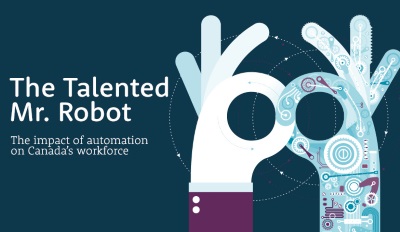
Automation and the Information Professions
June 19, 2016
A new report from the Brookfield Institute for Innovation + Entrepreneurship at Ryerson University examines all major job categories in Canada and applies methodologies from Oxford University professors Frey and Osborne and McKinsey & Company to predict the extent to which technology could replace the functions in the next 10 to 20 years.
The vast majority of occupations that have a high risk of being aff ected by automation are in trades, transportation and equipment operation, natural resources and agriculture, sales and service occupations, manufacturing and utilities, office support and general administration, and technical occupations in health, natural and applied sciences.
Occupations that have a low risk of being aff ected by automation are fairly diverse, spanning the arts, culture, recreation and sport, management and supervisory positions, and professional occupations in a number of different fields such as education, law, health, nursing, as well as natural and applied sciences.
The Talented Mr. Robot: The impact of automation of the Canada’s workforce
Below is an extract of the information-related occupations from the report:
| NOC # | Occupation | Proportion of tasks that can be automated (McKinsey & Co) | Employed Canadian Labour Force (2011) | Probability of automation in the next 10-20 years (Frey and Osborne) |
|---|---|---|---|---|
| 0511 | Library, archive, museum and art gallery managers | 28.0% | 4,345 | 25.0% |
| 1213 | Supervisors, library, correspondence and related information workers | 22.0% | 6,390 | 1.4% |
| 1253 | Records management technicians | 75.0% | 7,855 | 95.0% |
| 1451 | Library assistants and clerks | 80.0% | 17,200 | 95.0% |
| 5111 | Librarians | 43.0% | 12,115 | 65.0% |
| 5112 | Conservators and curators | 42.5% | 1,790 | 29.8% |
| 5113 | Archivists | 7.0% | 2,430 | 76.0% |
| 5211 | Library and public archive technicians | 59.0% | 10,725 | 99.0% |
Add a new comment